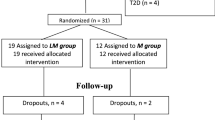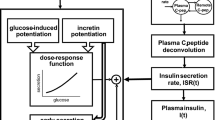Abstract
The aim of this study was to study the effects of pioglitazone on several diabetic parameters with subjects possessing distinct levels of insulin. Treatment naive patients with type 2 diabetes received 15–30 mg/day pioglitazone monotherapy. At 3 months, levels of insulin, C-peptide, HbA1c, HOMA-R, HOMA-B and BMI were compared with those at baseline between the low (below 5.9 μU/ml, n = 48), medium (11.9–6 μU/ml n = 39) and high (above 12 μU/ml, n = 33) insulin groups. At baseline, differences existed in the levels of HbA1c, insulin, C-peptide, HOMA-R, HOMA-B, and BMI between these groups. In the high-insulin group significant reductions of insulin/C-peptide levels were observed, while in the low-insulin group significant increases of insulin/C-peptide were observed. In the medium-insulin group, no significant changes were observed. In contrast, the HbA1c levels significantly and similarly decreased in all the groups. Significant correlations between the changes of insulin/C-peptide levels with pioglitazone and the baseline insulin/C-peptide levels were observed. HOMA-R showed greater reductions in the high-insulin group, while HOMA-B showed greater increases in the low-insulin group in comparison to other groups. Multiple regression analysis revealed that the baseline insulin level is the predominant determinant of the changes of insulin levels with pioglitazone. These results suggest that pioglitazone appears to have two effects: to reduce insulin resistance (and lower insulin) and to improve beta-cell function (and increase insulin). The predominance of these effects appears to be determined by the insulin levels. Based on these data, a novel physiological model showing that pioglitazone may shift the natural history of diabetes toward an earlier stage (rejuvenation of beta-cell function) will be presented.





Similar content being viewed by others
Abbreviations
- FBG:
-
Fasting blood glucose
- GOT:
-
Glutamic oxalacetic transaminases
- GPT:
-
Glutamic pyruvic transaminases
- CRE:
-
Creatinine
- BNP:
-
Brain natrium peptide
- HOMA-R and -B:
-
Homeostasis model assessment-R and -beta
- BMI:
-
Body mass index
References
C.J. Rhodes, Type 2 diabetes-a matter of beta-cell life and death? Science 307(5708), 380–384 (2005)
H. Walter, G. Lubben, Potential role of oral thiazolidinedione therapy in preserving beta-cell function in type 2 diabetes mellitus. Drugs 65(1), 1–13 (2005)
D.M. Nathan, J.B. Buse, M.B. Davidson, R.J. Heine, R.R. Holman, R. Sherwin, B. Zinman, Management of hyperglycemia in type 2 diabetes: a consensus algorithm for the initiation and adjustment of therapy: a consensus statement from the American Diabetes Association and the European Association for the Study of Diabetes. Diabetes Care 29(8), 1963–1972 (2006)
Z.T. Bloomgarden, Thiazolidinediones. Diabetes Care 28(2), 488–493 (2005)
A. Gastaldelli, E. Ferrannini, Y. Miyazaki, M. Matsuda, A. Mari, R.A. DeFronzo, Thiazolidinediones improve beta-cell function in type 2 diabetic patients. Am. J. Physiol. Endocrinol. Metab. 292(3), E871–E883 (2007)
L.C. Bollheimer, S. Troll, H. Landauer, C.E. Wrede, J. Scholmerich, R. Buettner, Insulin-sparing effects of troglitazone in rat pancreatic islets. J. Mol. Endocrinol. 31(1), 61–69 (2003)
K. Masuda, Y. Okamoto, Y. Tsuura, S. Kato, T. Miura, K. Tsuda, H. Horikoshi, H. Ishida, Y. Seino, Effects of Troglitazone (CS-045) on insulin secretion in isolated rat pancreatic islets and HIT cells: an insulinotropic mechanism distinct from glibenclamide. Diabetologia 38(1), 24–30 (1995)
Y. Miyazaki, M. Matsuda, R.A. DeFronzo, Dose-response effect of pioglitazone on insulin sensitivity and insulin secretion in type 2 diabetes. Diabetes Care 25(3), 517–523 (2002)
T.M. Wallace, J.C. Levy, D.R. Matthews, An increase in insulin sensitivity and basal beta-cell function in diabetic subjects treated with pioglitazone in a placebo-controlled randomized study. Diabet. Med. 21(6), 568–576 (2004)
C.Y. Lin, T. Gurlo, L. Haataja, W.A. Hsueh, P.C. Butler, Activation of peroxisome proliferator-activated receptor-gamma by rosiglitazone protects human islet cells against human islet amyloid polypeptide toxicity by a phosphatidylinositol 3′-kinase-dependent pathway. J. Clin. Endocrinol. Metab. 90(12), 6678–6686 (2005)
R. Kawamori, T. Kadowaki, M. Onji, Y. Seino, Y. Akanuma, on behalf of the PRACTICAL Study Group. Hepatic safety profile and glycemic control of pioglitazone in more than 20, 000 patients with type 2 diabetes mellitus: postmarketing surveillance study in Japan. Diabetes Res. Clin. Pract. 76(2), 229–235 (2007)
J. Girard, Contribution of free fatty acids to impairment of insulin secretion and action: mechanism of beta-cell lipotoxicity. Med. Sci. (Paris) 19(8–9), 827–833 (2003)
M. Manco, M. Calvani, G. Mingrone, Effects of dietary fatty acids on insulin sensitivity and secretion. Diabetes Obes. Metab. 6(6), 402–413 (2004)
H. Yokoshiki, M. Sunagawa, T. Seki, N. Sperelakis, ATP-sensitive K+ channels in pancreatic, cardiac, and vascular smooth muscle cells. Am. J. Physiol. 274(1 Pt 1), C25–C37 (1998)
M.I. Harris, Classification and diagnostic criteria for diabetes mellitus and other categories of glucose intolerance. Prim. Care 15(2), 205–225 (1988)
M. Tominaga, Diagnostic criteria for diabetes mellitus. Rinsho Byori 47(10), 901–908 (1999)
P.P. Rickham, Human experimentation. Code of ethics of the world medical association. Declaration of Helsinki. Br. Med. J. 2(5402), 177 (1964)
D.R. Matthews, J.P. Hosker, A.S. Rudenski, B.A. Naylor, D.F. Treacher, R.C. Turner, Homeostasis model assessment: insulin resistance and beta-cell function from fasting plasma glucose and insulin concentrations in man. Diabetologia 28(7), 412–419 (1985)
T.M. Wallace, J.C. Levy, D.R. Matthews, Use and abuse of HOMA modeling. Diabetes Care 27(6), 1487–1495 (2004)
Acknowledgment
The author thanks Drs. Jan Wajs, Makoto Hayashi, Naoki Takeda, Michi Idoi, Shinichi Sakurai and Hiroyuki Tabata for valuable comments and discussions.
Author information
Authors and Affiliations
Corresponding author
Rights and permissions
About this article
Cite this article
Kutoh, E., Fukushima, T. Insulin-dependent actions of pioglitazone in newly diagnosed, drug naïve patients with type 2 diabetes. Endocr 35, 333–340 (2009). https://doi.org/10.1007/s12020-009-9174-2
Received:
Accepted:
Published:
Issue Date:
DOI: https://doi.org/10.1007/s12020-009-9174-2




